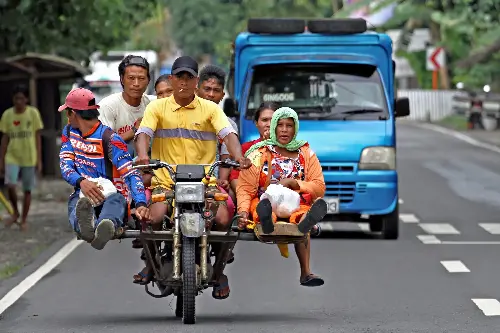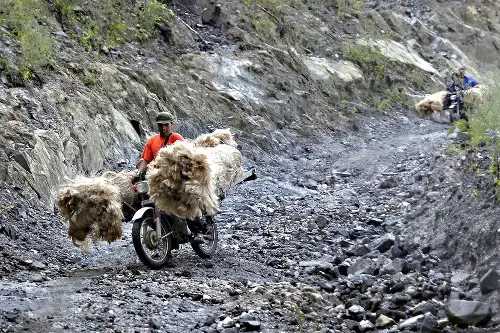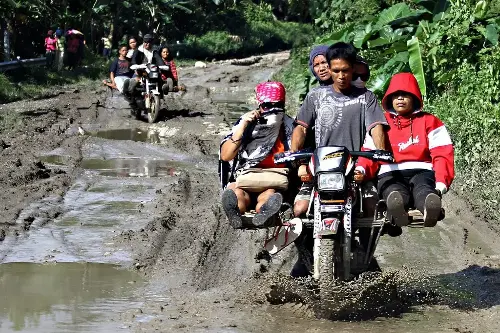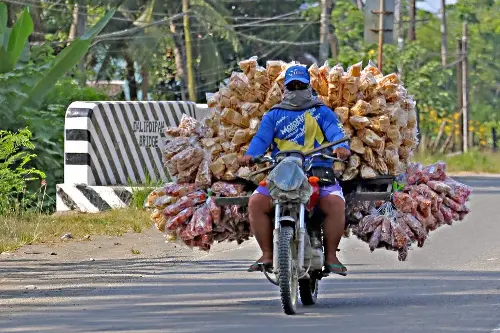
AGUSAN DEL SUR, Philippines – Twenty-eight-year-old Christine Joy Buag, a cashier in Talacogon, Agusan del Sur, vouched for the reliability of their local vehicle called skylab or katig. Unlike conventional rides, Buag said skylabs are essential and helpful for far-flung and geographically isolated communities like theirs.
“None of the conventional rides can penetrate deep into far-flung areas. We brought relief and essential services to these communities; nurses and midwives travel on katig to provide much-needed services. During flooding, katig can be transported on makeshift rafts or carried by people on their shoulders,” Buag shared.

Popular in rural areas in Mindanao, the skylab or katig is a motorcycle modified to accommodate more passengers or cargo. It bears similarities with boats’ katig because wood, like wings which serve as makeshift seats or cargo spaces, is placed on both sides of the motorcycle.
However, locals are observing a gradual decline in the number of these vehicles. According to some skylab drivers, seldom do they see 10 or 20 skylabs hitting the road these days.
“It is far from what it was before. Now, you won’t see as many katig on the roads compared to years ago as more roads have been fixed and paved, allowing vehicles to access areas that were previously off-limits to four-wheeled transport,” said James Asalan, a 20-year-old skylab driver from the remote village of Binikilan in San Luis, Agusan del Sur.
Asalan explained that another reason for the decline is the introduction of the Philippine versions of Thailand and India’s tuk-tuk, commonly known to locals as bao-bao. These vehicles are gaining popularity for their ability to climb steep inclines, with more powerful engines than traditional tricycles.
“Since I was a small kid, this has been our village’s lifeline. I’ve been driving katig for four years now, since I was 17. I ferry passengers to the town center and to other communities within San Luis and nearby towns like Talacogon. But now, if you look at the transport terminals, you can only see two or three parked, waiting for passengers,” Asalan added.

“Another factor for the slow decline of our iconic skylab is that while our road networks have improved, it paved the way for better means of transportation such as what we call the bao-bao, where it is far safer and it protects the passenger from rain or from getting wet. Unfortunately, it cannot carry the same number of passengers compared to the skylab,” Benecio Manliguez, chairperson of Barangay Mabuhay in the town of Prosperidad in Agusan del Sur, explained.
Origin
Behind the serene beauty of the mountain ranges of the Caraga region, skylabs can be spotted dominating the roads. When you find yourself in a remote village and someone invites you to visit another village over the next mountain, saying, “Laag ta, sakay sa katig,” you’re in for an adrenaline-filled ride you won’t forget. “Laag” in Bisaya means to roam or stray off the beaten path.
The skylab first gained popularity in the late 1980s, in the far-flung villages and mountainous areas of Monkayo, Montavista, Maragusan, and New Bataan in Compostela Valley (now Davao de Oro). According to locals, the single motorcycle, modified to accommodate makeshift outriggers on both sides, was initially intended for transporting items and heavy loads. This configuration gave more space for more passengers, making each trip cost-efficient.
By the 1990s, skylabs spread to nearby provinces in Caraga, including Agusan del Sur, Agusan del Norte, Surigao del Sur, and Surigao del Norte. The vehicle, which evolved from the single motorcycle known as habal-habal, could carry three times its normal cargo capacity — between 8 to 13 people.
The “wings” added to the motorcycle earned it the name skylab, resembling the 1973 United States space station, which had wings-like solar panels. As the skylab reached other parts of Caraga and Northern Mindanao, including Misamis Oriental and Bukidnon, it earned its other name, katig.

Despite its dwindling numbers, the skylab will remain a vital part of Mindanawons’ lives. Locals don’t see these vehicles going away anytime soon.
Manliguez said the skylab is still being used today as there are still communities situated in the very hard-to-reach mountain villages, valleys between large mountains, and forests where roads are still impossible for three- to four-wheeled vehicles to reach. – Rappler.com